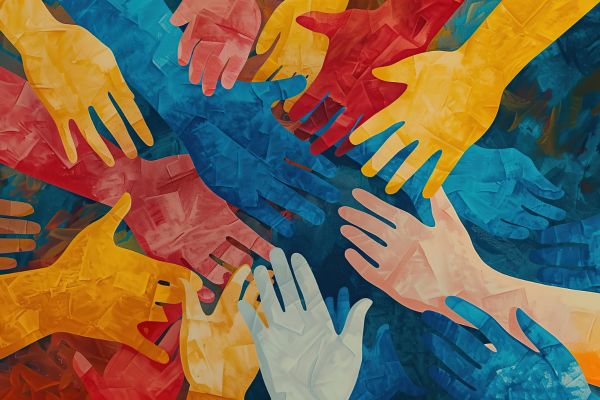Insights
INSIGHTS
All Topics
How British charities are using digital around the world
24 Nov 2023by Christine Chiu
The focus isn’t always at home – let’s check out where we are internationally
Outside of the U.K., humanitarian and environmental problems demand global solutions. International work helps those in need and raises Britain’s profile.
Charities play an outsized role in solving problems. British ones are making huge strides to solve international problems and curb environmental damage. They not only send volunteers and staff to help, but leverage digital expertise to achieve their missions.
We take a look at what British charities are doing on the global stage.
UK charities delivering digital
Coined by Lloyd Morrisett, the “digital divide” refers to a gap in who has access to the internet and digital technology.
The term has also been used by former U.S. Vice President Al Gore. He said: “We need to bridge the digital divide not just within our country, but among countries. Only by giving people around the world access to this technology can they tap into the potential of the Information Age.”
In 2000, Gore noted that the digital divide mirrors other negative socio-economic trends that don’t sit well with charities, following racial and economic lines. Digital exclusion is still known to exacerbate other systemic inequalities.
Charities are taking up the mantle and expanding access to digital internationally.
Computer Aid, based out of London, “aims to improve outcomes for project beneficiaries, whether it be students at a school where a computer lab has been installed, or community members.”
The international charity accepts donations from other organisations. They deliver the infrastructure to Africa and South America. The charity sets up learning centres powered by solar modules and has donated over 271,000 computers and held nearly 4,000 courses. Computer Aid addresses many ambitions. These include recycling, expanding digital access, and use of renewable energy.
Better care for our furry friends
British charities are using digital to spread the word on how to look after humanity’s animal friends.
Wild Welfare’s mission is to provide the best possible life for captive animals. This means improving care for working beasts and those in zoos or other managed environments. The challenge is daunting. The target geographies are Vietnam and Thailand.
Working with The Jeanne Marchig International Centre for Animal Welfare Education, the charity launched an online animal husbandry programme. The free resource empowers owners to look after their stock with care and compassion. Best of all, the modules can be delivered across mobile and other devices.
Simon Marsh, the charity’s director says: “The Wild About Welfare programme has been designed to upskill staff working in captive wildlife facilities around the world and give them the knowledge to be able to deliver good care and welfare to their animals.”
Remote monitoring is also a boon to The Donkey Sanctuary. Like Wild Welfare, the equine charity’s purpose is to track and improve the living and working environment.
Using open-data kit and G.P.S., The Donkey Sanctuary has developed a welfare assessment tool. The programme assesses how to improve the lives of the animals.
The results are impressive. The data is being used to shed light on hotspot locations where hoof problems or wounds are concentrated. From there, interventions are deployed and the issues themselves are prevented.
Charities harness remote monitoring
Tech is also bridging geographical gaps. Two examples stand out.
Established on the forefront of conservation, W.W.F. scientists and field workers take millions of photos of animals. The analytics are complex – it takes weeks to identify species.
Collaboration is solving the problem.
Along with the Zoological Society of London, Google, and a few others, W.W.F. founded Wildlife Insights, a tech and data-driven conservation partnership. Professional and amateur wildlife spotters upload their pictures for the artificial intelligence to identify animals in their habitats.
The implications are large. The dataset gathered not only quickens the pace of identification but informs naturalists on location and trends. The data is available on an open-source format, so even amateur researchers can participate.
Other charities use monitoring to improve efficiency and operations.
Charity:water’s water pump management is an interesting case study. The charity installs pumps in remote and rural communities. This makes communication a challenge when it comes to project management, impact, and repairs.
To solve the problem, the charity installs remote sensors on the pumps which sends data directly to the cloud. In real time, teams monitor when the project breaks ground and the flow of water once the system is running.
Across four years of monitoring, Charity:water collected a huge amount of data. However, they didn’t have the capability to analyse it.
Big data was called in to help. Working with Accenture’s Tech4Good programme, Charity:water and the I.T. giant analysed the data to discern trends. They developed a new water consumption model as a result. The partnership also produced an alert system which the charity uses to prevent water failures.
Christine Chiu
More on this topic
Recommended Products
Recommended Products
Related Videos
27 Jan 2025by Josie Sparling
How digital access challenges impact charities and service users
24 Jan 2025by Joe Lepper
The charities tackling prison overcrowding
Our Events
Charity Digital Academy
Our courses aim, in just three hours, to enhance soft skills and hard skills, boost your knowledge of finance and artificial intelligence, and supercharge your digital capabilities. Check out some of the incredible options by clicking here.






















